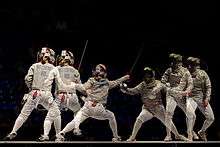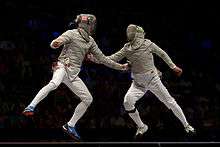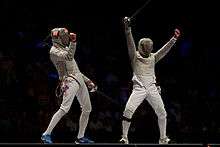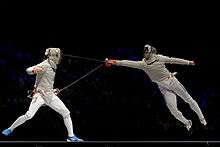Sabre (fencing)
The sabre (US English: saber, both pronounced /ˈseɪbər/) is one of the three disciplines of modern fencing.[1] The sabre weapon is for thrusting and cutting with both the cutting edge and the back of the blade[2] (unlike other modern fencing weapons, the épée and foil, where the methods of making a hit are scored using the point of the blade[2]).

The informal term sabreur refers to a male fencer who follows the discipline; sabreuse is the female equivalent.
The Sabre Weapon

| Name | Description | FIE Regulated | |
|---|---|---|---|
| Guard | 17 × 14 × 15 cm | Maximum section, Protects the fencer's hand. | Yes |
| Blade | 88 cm | The blade attached into the handle, steel. | Yes |
| Total Length | 105 cm | Total maximum the dimension of the sabre. | Yes |
| Total Weight | 500 g | Total maximum weight ready for use. | Yes |
"The blade, which must be of steel, is approximately rectangular in section. The maximum length of the blade is 88 cm. The minimum width of the blade, which must be at the button, is 4 mm; its thickness, also immediately below the button, must be at least 1.2 mm." [3]
The cross-sectional profile of the sabre blade is commonly a V-shaped base which transitions to a flat rectangular shaped end with most blade variants, however this is dependent on the how it is manufactured. This allows the blade to be flexible towards the end. According to regulation, manufacturers must acknowledge that the blade must be fixed horizontally at a point 70 cm (27.5591 in) from the tip of the blade.[4]
Standardised Adult (size 5) blades are 88 cm (34.6457 in) in length. (excluding other components). At the end of the blade, the point is folded over itself to form a "button" which, when viewed end on, must have a square or rectangular section of 4 mm - 6 mm no larger or smaller. The button must not be any more than 3 mm from the end of the 88 cm blade section.[4]
The guard is full in shape, made in one piece and is externally smooth, the curvature of the guard is continuous without any aesthetic perforations or rims. The interior of the guard is fully insulated by either paint or a pad. The guard is designed to provide the hand adequate protection to ensure that injury does not occur which may hinder the performance of the fencer. Guards are dimensionally measured 15 cm by 14 cm in section where the blade is parallel with the axis of the gauge.[5]
On electrical sabres, a socket for the body wire is found underneath the bell guard. A fastener known as a pommel is attached to the end of the sword to keep the bell guard and handle on, it electrically separates the handle and the guard.
The conventional handle of the sabre is shaped so that it may be held so that the hand may slide down to gain further extension of the weapon relative to the fencer. Other grips which form various shapes are incompatible and impractical with sabre as they limit the movement of the hand, and are likely to be ergonomically incompatible with the guard.
The entire weapon is generally 105 cm (41 inches) long; the maximum weight is 500g, but most competition swords are closer to 400g. It is shorter than the foil or épée, and lighter than the épée, hence physically easier to move swiftly and decisively. However the integrity of the sabre blade is not as strong as other weapons as it is more likely to break due to the design.[6]
Electrical Sabre
Like other weapons used in fencing, the modern sabre uses an electrical connection to register touches. The sabreur wears a lamé, a conductive jacket, to complete the circuit and register a touch to a valid target.
Sabre was the last weapon in fencing to make the transition over to using electrical equipment. This occurred in 1988, 32 years after foil and 52 years after the épée. In 2004, immediately following the Athens Summer Olympics, the timing for recording a touch was shortened from its previous setting, dramatically altering the sport and method in which a touch is scored.
Unlike the other two weapons, there is very little difference between an electric sabre and a steam or dry (non-electric) one. The blade itself is the same in steam and electric sabres, as there is no need for a blade wire or pressure-sensitive tip in an electric sabre. An electric sabre has a socket, which is generally a 2-prong or bayonet foil socket with the two contacts shorted together. The electric sabre also has insulation on the pommel and on the inside of the guard to prevent an electrical connection between the sabre and the lamé. This is undesirable because it effectively extends the lamé onto the sabre, causing any blade contact to be registered as a valid touch.
Early electric sabres were equipped with a capteur socket. The capteur was a small mechanical accelerometer that was intended to distinguish between a good cut and a mere touch of the blade against the target. In November 2019 the FIE announced their intention to re-introduce the capteur to sabre using modern accelerometer technology. [7]
Target area

The general target area for the discipline contains the entire torso above the waist, the head, and the arms up to the wrist of which a valid hit may be scored. The legs, hand and feet are excluded from the target area.
A single circuit for the entire target area used in scoring systems is formed by multiple conductive equipment:
- Glove : Gloves usually provide the conductive 'manchette' / cuff used in physical conjunction and contact with the lamé. Usually worn over the lamé. The hand may not be conductive.
- Lamé : The conductive lamé which covers the torso and arms of the fencer. Conductivity of the lamé does not extend past the waistline to meet with the target criteria.
- Mask : The conductive mask, usually directly connected to the lamé through a wire with a crocodile clip on each ends.
Because touches can be scored using the edge of the blade, there is no need for a pressure-sensitive head to be present on the end of the blade (thus having the button). When fencing "electric" (as opposed to "steam" or "dry") a current runs through the sabre blade. When the blade comes into contact with the lamé, the electrical mask, or the manchette, the current flows through the body cord and interacts with the scoring equipment.
Scoring

Central Judging Apparatus
Also known as the 'Scoring apparatus' or Box.
As for all electrical apparatus used in modern fencing, the referee's final judgement is aided by the apparatus taking into account of possible failure.[8] Most sabre hits are registered by light signals (red and green distinguishable for each fencer) placed on top of the sabre apparatus and accompanied by audible signal(s) [9] consisting of either of a short ring, or of a continuous note limited to two seconds.
In some circumstances a white signal is indicated when a fencer has hit off-target.
Lockout Period
The 'Lockout Period', an informal term to describe the minimum amount of time between registered touches respective of the target area.[10] This period is set into the electrical apparatus to aid judgement.
Recent regulation adjustments to the 'functioning times of the scoring apparatuses' following from the 2016 Olympic games modified the registering times from 120 ms (± 10 ms) to 170 ms (± 10 ms) . Scoring apparatuses with the new modification are marked with a 2 × 4 cm, magenta identification label. Bearing in black text : 'FIE 2016'.[11]
| Characteristics to be modified | Former | New |
| Time for double hit | 120 ms ± 10 | 170 ms ± 10 |
- If both hits occur simultaneously and the time difference is higher than the lockout period, one signal is displayed by the judging apparatus. The referee is likely to award the point to the first hit.
- If both hits occur simultaneously within the lockout period, both signals are displayed - in such occurrence final judgement of the score is determined by the 'right of way'.
Changing the lockout timing effectively changed the way with which the sabre was fenced, making it faster with greater emphasis on footwork. Although the essential nature of the game would remain the same, the strategies for attack and defense would need to be rethought.
The timing change was initially greeted with a degree of controversy, as many fencers were accustomed to having the longer timings. This made the techniques then employed vulnerable to fast stop-cuts (a hit made by the defender that lands whilst the attacker is still beginning an attack, also known as a skyhook) or remisés (a second attack made by the original attacker after the first has technically finished). It was commonly regarded that the shorter timings would only encourage poor technique and an "attack only" mentality, negating much of the art of the sport.
Remises and stop-cuts would not normally score a point as a hit by the attacker would take priority. However the hit made with priority may arrive too late under the shorter timings to register, and so the stop-cuts and remises would indeed score.
As a result of the narrower timings, the efficacy of attacks into preparation was increased, meaning that it was now more critical that the preparing fencer must already have begun an attack by the time the two fencers were in hitting distance of each other.
The techniques of how to parry and riposte have been extended. The solid parries, used extensively before the change of timings, would be supplemented by an additional step back by the defender to avoid the attacker remising (continuing to push their blade after their attack has technically done) or else the defence to be performed as a beat-attack, an extending arm that deflects the oncoming attack halfway through the extension before hitting the original attacker's target area.
With hindsight, the shorter timings seem to have encouraged a tightening and refinement of the original techniques with smaller, neater moves so that, on the whole, sabre fencing became faster and more precise than it had ever been before.
Right of way

When both signals indicate, it rests upon the referee to decide which fencer scores the point.[12] The decision is based on the concept of Right of Way which gives the point to the fencer who had priority, i.e. the attacking fencer. As with foil, the other right of way weapon, priority is gained in many ways, which can be broken down into active, passive, and defensive categories:
- Active:
- Attacking the opponent. (In fencing the word "attack" is defined as: the initial offensive action made by extending the arm and continuously threatening the opponent's target, preceding the launching of the lunge or step. The flèche is illegal in sabre as a "crossover". In sabre the threat may be established with the point or the cutting edge, and the end of the attack coincides with the moment the front foot touches the strip). Hitting with the blade after the front foot has landed constitutes a remise of the attack, and so an opponent's attack delivered at the same time would take the right of way in this case.
- Executing an attack which is preceded by a beat on the opponent's weapon.
- Passive:
- Establishing a point in line prior to the opponent initiating an attack. The hit must be completed with the point. Derobement of the opponent's attempts to beat are allowed, but the point must continue to threaten the target, and a derobement when there is no attempt to beat also loses the right of way.
- If an attack is executed against an opponent who has point in line, the attacker must remove the point in line (i.e., with a beat, etc.). Simply making contact with the blade is insufficient and the blade must actually be moved aside.
- If an attempt to beat the blade is made, and missed (because of a derobe), the opponent maintains the right of way.
- Point in line can lose priorities regardless of whether the fencer is advancing, stationary, or retreating,[12] but is lost if arm is bent or the point is moved away from targeting the opponent.
- Defensive:
- Executing an immediate return offence following the opponent's failed attack; the failed attack can be the result of a parry (i.e., parry-riposte), or because it has fallen short of the target (commonly termed a "get-away-go"), or in any other way missed.
If neither fencer has 'right of way' in a double touch situation (typically, if both initiate the attack simultaneously in so far as the director can determine), the action is called a "simultaneous attack" and no point is awarded unless an attack is initiated first and is not parried or missed.
Right of way rules were initially established to encourage fencers to use parries and other techniques in order to hit without being hit, as they would logically desire to do if they were using sharp swords. Subsequently, the rules of right of way have been altered simply to keep the strategy and technique of sabre interesting and (relatively) easy to understand.
Referee

The referee may halt the action for reasons such as a safety hazard, fencer injury, or violation of the rules. When the referee says "halt", no further action may score a point. For cases of rules violations, the referee may choose to either warn the offender or show him or her a penalty card. A warning has no scoring implication. Cards, on the other hand, have further penalties:
- Yellow Card: Offender's touch may be annulled, similar to a warning. This may be given if a fencer moves forward before "fence" is heard, or unnecessary action after "halt" is heard.
- Red Card: Offender's touch usually annulled, point awarded to opponent. Two yellow cards result in a red card.
- Black Card: Offender is removed from the tournament and the building. This can be caused by refusing to salute, or falsifying documents and covering up breaches in rules.
Technique

At sabre, it is generally easier to attack than to defend (for example, the timing favours remises) and high-level international sabre fencing is often very fast and very simple, although when required, top sabreurs do display an extended repertoire of tactical devices. In response to the relatively high speed of sabre fencing (sabre is the fastest sport in the world combat wise), the rules for sabre were changed to prohibit the forward cross-over (where the back foot passes the front foot) - it is now a cardable offence. Thus, the flèche attack is no longer permissible, so sabre fencers have instead begun to use a "flunge" (flying lunge). This attack begins like a flèche, but the fencer pushes off from the ground and moves quickly forward, attempting to land a hit before their feet cross over. Similarly, "running attacks" — consisting of a failed flèche followed by continuous remises — have also been eliminated.
Sabre defense comprises the three primary parries:
- Tierce, high outside
- Quarte, high inside
- Quinte, head
and three secondary parries:
- Prime, generally taken in a sweeping motion to cover the entire inside line - often used instead of quarte when moving from quinte
- Seconde, either guarding the low outside line - often used instead of tierce when moving from a "point-in-line"
- Sixte, Blade up and to the outside, wrist supinated. This parry can be Lateral or Circular. There is great debate over whether this guarde actually exists, or whether it is just a slightly extended tierce, just as in foil and épée parry nine is viewed by some to be just a high sixte.

Another parry, lesser-known, but which works against opponents of the same handedness, is referred to as "the Hungarian". This parry is most useful when both fencers charge off the line towards each other. To perform the Hungarian, a fencer throws a "prime" parry when the opponent is within striking distance and sweeps upward into a "quinte" position, covering (in the process) nearly all target area, and performs the riposte as with a normal "quinte" parry. The Hungarian technique often works best if a step or angle is taken in the opposite direction of the "prime" parry. This technique will not work with two fencers of opposite handedness.
It follows from the nature of sabre parries (they block an incoming attack rather than deflecting it as in foil and épée) that they are static and must be taken as late as possible to avoid being duped by a feint attack, committing to a parry in the wrong line and being unable to change parry (which often involves completely altering the orientation of the blade while moving and rotating the wrist and forearm) to defend against the real attack quickly enough.
Circles, such as Circle 3, 4, and 5, defend against stabs to the body, which an ordinary parry would not block. This is extremely useful, as it is highly versatile, covering much of the target area.
Each fencing weapon has a different tempo, and the tempo for épée and foil is rather slow with sudden bursts of speed. Sabre is fast throughout the entire touch. However, many coaches are urging pupils to slow down the pace by taking smaller steps instead of larger ones.
References
- The Fencing Center, Sabre Fencing (accessed 16 Nov 2015)
- http://static.fie.org/uploads/18/92877-Technical%20rules%20ang.pdf t.90 , t.76
- http://static.fie.org/uploads/18/92800-book%20m%20ang.pdf m.23.1
- http://static.fie.org/uploads/18/92800-book%20m%20ang.pdf m.23.5 (a)
- http://static.fie.org/uploads/18/92800-book%20m%20ang.pdf m.24
- http://static.fie.org/uploads/18/92800-book%20m%20ang.pdf Figure 13. Sabre dimension (contd.)
- https://fie.org/articles/909
- http://static.fie.org/uploads/18/92877-Technical%20rules%20ang.pdf t.80, t.99
- http://static.fie.org/uploads/18/92800-book%20m%20ang.pdf m.51.3
- "Fencing Rules for the Novice Parent: Strategy differences for foil, epee, and sabre". Academy of Fencing Master's Blog. July 7, 2014.
- http://static.fie.org/uploads/9/49267-NEW%20RULES%20FOR%20THE%20SABER.pdf
- Surrey County Fencing Union, Sabre Refereeing Hints, Refereeing (accessed 16 November 2015)
References
- Amberger, J. Christoph (1998). The Secret History of the Sword: Adventures in Ancient Martial Arts. Burbank, California: Unique Publications. ISBN 1-892515-04-0.
- Luigi Barbasetti: The Art of the Sabre and the Epee. 1936. Reprint 2019. ISBN 978-3-96401-005-6.

